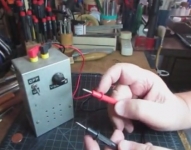Audible continuity checkers are very handy. If you have your eyes glued on the probes sitting next to some live capacitor or a rotating fan blade, you may not want to look away to check the reading on the ohm-meter.
Many modern VOMs have built-in audible continuity checkers. I built one that's just a bit different. Instead of sounding a fixed frequency tone when the circuit is completed, this one sounds a tone the frequency of which is inversely proportional to the resistance in the circuit. It won't replace an ohm-meter unless you have perfect pitch but it will alert you to less than perfect connections.
This appallingly dull (but blissfully short) video will demonstrate it in action. [The real reason for the video is to record the sound the device makes.] A continuous click proves the device is working and signals an open circuit. When the circuit is completed the device emits a high-pitched tone. At the end of the video I grasp the probes to complete the circuit through my body. As I modulate the pressure applied with my fingers thus changing the resistance of my connection to the probes, you can hear the pitch of the sound change.
The circuit is very simple. The only active device is a 555 wired as a multi-vibrator. In this role, an RC circuit determines the frequency it emits (which drives the loudspeaker directly). A 1M resistor in this circuit creates the low frequency click when the circuit is open. The probes are wired in parallel with this resistor so, when shorted, the resistor is removed from the circuit and the 10K resistor generates the high-pitched tone. Resistances other than zero and infinity across the 1M produce other effective resistances which generate other frequencies.



 LinkBack URL
LinkBack URL About LinkBacks
About LinkBacks



 Reply With Quote
Reply With Quote




Bookmarks